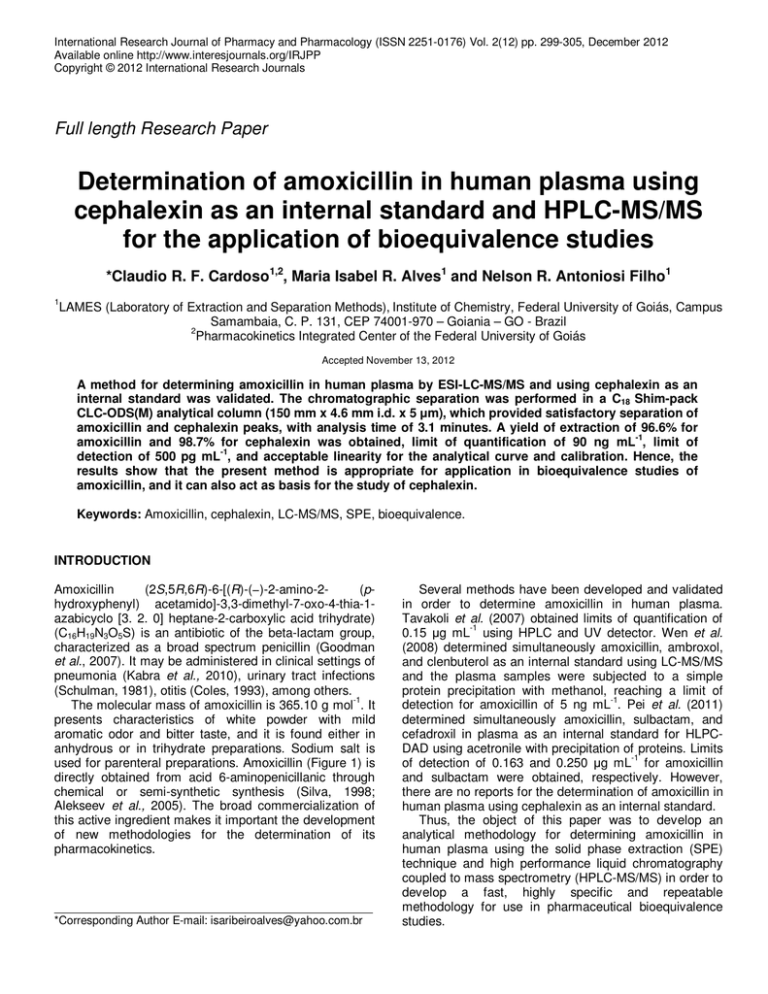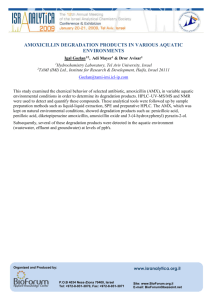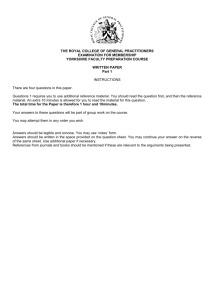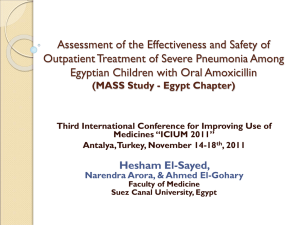Document 14262952
advertisement

International Research Journal of Pharmacy and Pharmacology (ISSN 2251-0176) Vol. 2(12) pp. 299-305, December 2012 Available online http://www.interesjournals.org/IRJPP Copyright © 2012 International Research Journals Full length Research Paper Determination of amoxicillin in human plasma using cephalexin as an internal standard and HPLC-MS/MS for the application of bioequivalence studies *Claudio R. F. Cardoso1,2, Maria Isabel R. Alves1 and Nelson R. Antoniosi Filho1 1 LAMES (Laboratory of Extraction and Separation Methods), Institute of Chemistry, Federal University of Goiás, Campus Samambaia, C. P. 131, CEP 74001-970 – Goiania – GO - Brazil 2 Pharmacokinetics Integrated Center of the Federal University of Goiás Accepted November 13, 2012 A method for determining amoxicillin in human plasma by ESI-LC-MS/MS and using cephalexin as an internal standard was validated. The chromatographic separation was performed in a C18 Shim-pack CLC-ODS(M) analytical column (150 mm x 4.6 mm i.d. x 5 µm), which provided satisfactory separation of amoxicillin and cephalexin peaks, with analysis time of 3.1 minutes. A yield of extraction of 96.6% for amoxicillin and 98.7% for cephalexin was obtained, limit of quantification of 90 ng mL-1, limit of detection of 500 pg mL-1, and acceptable linearity for the analytical curve and calibration. Hence, the results show that the present method is appropriate for application in bioequivalence studies of amoxicillin, and it can also act as basis for the study of cephalexin. Keywords: Amoxicillin, cephalexin, LC-MS/MS, SPE, bioequivalence. INTRODUCTION Amoxicillin (2S,5R,6R)-6-[(R)-(−)-2-amino-2(phydroxyphenyl) acetamido]-3,3-dimethyl-7-oxo-4-thia-1azabicyclo [3. 2. 0] heptane-2-carboxylic acid trihydrate) (C16H19N3O5S) is an antibiotic of the beta-lactam group, characterized as a broad spectrum penicillin (Goodman et al., 2007). It may be administered in clinical settings of pneumonia (Kabra et al., 2010), urinary tract infections (Schulman, 1981), otitis (Coles, 1993), among others. The molecular mass of amoxicillin is 365.10 g mol-1. It presents characteristics of white powder with mild aromatic odor and bitter taste, and it is found either in anhydrous or in trihydrate preparations. Sodium salt is used for parenteral preparations. Amoxicillin (Figure 1) is directly obtained from acid 6-aminopenicillanic through chemical or semi-synthetic synthesis (Silva, 1998; Alekseev et al., 2005). The broad commercialization of this active ingredient makes it important the development of new methodologies for the determination of its pharmacokinetics. *Corresponding Author E-mail: isaribeiroalves@yahoo.com.br Several methods have been developed and validated in order to determine amoxicillin in human plasma. Tavakoli et al. (2007) obtained limits of quantification of -1 0.15 µg mL using HPLC and UV detector. Wen et al. (2008) determined simultaneously amoxicillin, ambroxol, and clenbuterol as an internal standard using LC-MS/MS and the plasma samples were subjected to a simple protein precipitation with methanol, reaching a limit of detection for amoxicillin of 5 ng mL-1. Pei et al. (2011) determined simultaneously amoxicillin, sulbactam, and cefadroxil in plasma as an internal standard for HLPCDAD using acetronile with precipitation of proteins. Limits of detection of 0.163 and 0.250 µg mL-1 for amoxicillin and sulbactam were obtained, respectively. However, there are no reports for the determination of amoxicillin in human plasma using cephalexin as an internal standard. Thus, the object of this paper was to develop an analytical methodology for determining amoxicillin in human plasma using the solid phase extraction (SPE) technique and high performance liquid chromatography coupled to mass spectrometry (HPLC-MS/MS) in order to develop a fast, highly specific and repeatable methodology for use in pharmaceutical bioequivalence studies. 300 Int. Res. J. Pharm. Pharmacol. Figure 1. Chemical structure of amoxicillin. Experimental Chemicals and reagents All the processes used ultrapure water generated by the ultra-purification system Mille-Q® Gradient A10, by Millipore. The HPLC-grade reagents used in the present study were purchased by Merck®. Reference standards were used upon authentication of origin and indication of a ‘Certificate of Analysis (CA)’. The primary standards for amoxicillin and cephalexin were obtained at United Stated Pharmacopeia – USP. Instrumentation and Chromatographic Conditions The samples were analyzed in a HPLC SHIMADZU AD Vp chromatograph (Shimadzu, Japan), equipped with a degasser and autosampler, coupled with a triple quadrupole (Micromass, UK) Quattro LC mass spectrometer (MS-MS), equipped with ion sources Zspray type. The chromatographic analysis were performed using a C18 Shim-pack CLC-ODS(M) (150 mm x 4.6 mm i.d. x 5 µm) analytical column (Shimadzu, Japan) with an outflow of 700 µL min-1 for the mobile phase, comprised of a mixture of aqueous formic acid solution 0.1% and acetonitrile (77:23 v/v), with a postcolumn split of 1:3 proportion. The system pressure operated between 85 to 95 bar and the column and sampler were kept at a controlled temperature of 22°C. Injection volume was 20 µL. Quattro LC (MS-MS) mass spectrometer operated on positive electrospray ionization (ESI), operating in 2channel MRM mode. As for the electrospray ionization, the following parameters were used: capillary in 3.00 kV; cone in 16.0 V for amoxicillin and in 17.0 V for cephalexin; extractor in 2.00V; RF lenses in 0.1V; source temperature of 110 oC; desolvation temperature of 250°C; cone gas outflow of 0.0 L/h; desolvation gas outflow of 530 L h-1. As for the quadrupoles of Quattro LC mass spectrometer, it was established the following conditions: resolution in LM 1 of 14.8; resolution in HM 1 of 14.8; ion 1 energy of 1.0 V; second hexapole input of 2.0 V; collision energy for amoxicillin of 21.0 eV; collision energy for cephalexin of 10.0 eV; output of 12 V; resolution in LM 2 of 12.0; resolution in HM 2 of 12.0; ion 2 energy of 1.0 V; multiplier of 650 V; reading time for each of the monitored mass (Dwell) of 0.5 seconds and reading time between the end of a screening and the beginning of the next one (Delay) of 0.1 seconds. The quasi-molecular ion (precursor ion) for amoxicillin was 366.1 Da and for cephalexin, 348.0 Da. The monitored fragment (product ion) for amoxicillin was 114.0 Da and for cephalexin, 157.9 Da. Preparation of stock and standard solutions A stock solution of 1.00 mg mL-1 amoxicillin in water:acetonitrile solution (50:50 v/v) was prepared. The amoxicillin stock solution was diluted for the preparation of standard solutions in the concentrations of 1.80; 5.00; 10.0; 25.0; 40.0; 60.0; 75.0; and 100 µg mL-1. A work solution for the cephalexin as an internal standard in the concentration of 20 µg mL-1 was prepared from the stock solution of 1.00 mg mL-1 in water:acetonitrile (50:50 v/v). All solutions were packed in polypropylene tubes with screw cap and stored at -20 °C. Sample preparation The samples of human plasma were defrosted at room temperature, homogenized in vortex, and centrifuged at 3400 rpm for 4 minutes to precipitate the suspended materials. As for the extraction, it used solid-phase (SPE) Waters Oasis HLB extraction cartridges of 1cc and 30 mg of adsorbent previously stored with 1 mL of methanol and 1 mL of ultrapure water. The amount of 250.00 µL of plasma was pipette in the cartridges, and then, adding -1 5.00 µL from the cephalexin 20.00 µg mL solution, followed by the addition of 450.00 µL of ultrapure water. The SPE cartridges were centrifuged at 3400 rpm for 4 minutes for the elution of plasma in the test-tube and retention of amoxicillin in the cartridge. The elution of amoxicillin and the internal standard were performed by adding 950.00 µL of extraction solvent acetonitrile:water (50:50 v/v) and, afterwards, the cartridges and their respective test-tubes were centrifuged once again for two minutes, at 3400 rpm, for the complete elution of the extraction solvent. Then, 50 µL from the aqueous 2% formic acid:acetonitrile (50:50 v/v) was added to the eluted solution, and the test-tubes were shaken in vortex Cardoso et al. 301 for 5 seconds. After that, the analysis was conducted through LC-MS/MS. Linearity The analytical curve was prepared at concentration levels of 0.0900; 0.250; 0.500; 1.25; 2.00; 3.00; 3.75; and 5.00 µg mL-1. Each SPE cartridge received 250 µL of human plasma, 50 µL of work solution related to each level of the analytical curve, and 50 µL of cephalexin as the internal standard solution. The solutions have been distributed to a final volume of 1.00 mL with 0.1% formic acid:acetonitrile (77:23 v/v). After that, 400 µL of ultrapure water was added in each cartridge and they were submitted to centrifugation. The sample quality controls (QC) were prepared in concentrations of 0.090 µg mL-1 (LQ); 0.250 µg mL-1 (CQB); 2.00 µg mL-1 (CQM); and 3.75 µg mL-1 (CQA) through the fortification of blank plasma and subsequent extraction process. Recovery of extraction The recovery of the extraction method was determined by the comparison of the areas obtained for amoxicillin peak related to the samples that were not submitted to the extraction process, considering yield of extraction of 100%, and to the samples submitted to the extraction process, in concentrations of 0.090; 0.250; 0.500; 1.250; 2.00; 3.00; 3.75; 5.00 µg mL-1. The internal standard showed a yield of extraction in replicates in the concentration of 1.00 µg mL-1. Precision and accuracy The precision and accuracy of the methodology was determined by the extraction of four samples containing cephalexin as the internal standard and amoxicillin in the concentrations LQ, CQB, CQM, and CQA, analyzed in replicates, in a procedure performed intraday and interdays. The criteria for approval for the coefficient of variation (CV) and relative standard deviation (RSD) were 15% (Anvisa RE n°899-2003). Stability The studies of amoxicillin and cephalexin stability in plasma were performed under three conditions. First, it assessed stability during three 24-hour freezing cycles at -20°C, followed by defrosting. After that, it assessed the stability of amoxicillin and cephalexin kept at room temperature for seven hours. The long-term stability was assessed for a storage period of fifteen days. The acceptance criteria were deviation in nominal concentration equal to or lesser than 15%, accuracy and precision equal to or lesser than 15% (Anvisa RE n°8992003). The long-term stability of the standard solution of the drug and internal standard in the biological fluid, at room temperature, was assessed after six hours from preparation. Such solutions were frozen at -20ºC for seven days, before analyses were performed. Biological Sample Samples for bioequivalence tests were collected at the Cardiology Institute of Anápolis, in the state of Goiás, Brazil. The study was comprised of 24 volunteers, and performed after approval by the Research Ethics Committee of the Federal University of Goiás. The blood samples were collected in a total volume of 8 mL. The blood was centrifuged and the plasma was removed. Plasma samples were frozen at -20ºC. Total sample volumes were 720, 1080, and 1440 ml samples for two, three, and four hospitalizations of volunteers, respectively, both for the study of amoxicillin in pills and oral suspension. Time for collecting samples was: 0.25; 0.50; 0.75; 1.00; 1.25; 1.50; 2.00; 2.50; 3.00; 4.00; 5.00; 6.00; 8.00; and 12.00 hours. RESULTS AND DISCUSSIONS Analyses using HPLC-MS/MS The chromatographic methodology applied in the present study allowed the amoxicillin and internal standard (cephalexin) to elute with a resolution of 1.66, with analysis time of 3.1 minutes (Figure 2), which represents satisfactory separation in a reduced period. Pei et al. (2011) and Tavakoli et al. (2007) obtained analysis time greater than 8 minutes, and in the study by Wen et al. (2008) the chromatographic analysis was performed in 4.2 minutes. Figure 3 presents the mass spectrum obtained for the standards of amoxicillin and cephalexin. The spectrum obtained in the positive electrospray mode, for the establishment of quasi-molecular ion (precursor ion) and fragments (product ion) of amoxicillin and cephalexin, were used to determine the ions monitored in MRM, that is, during monitoring of the ionized molecule and preestablished fragments, making the analysis even more sensitive (Straub and Voyksner, 1993). The amoxicillin was protonated and analyzed in the first mass spectrum, in which the most abundant ion was 366.1 Da, resulting from the addition of a proton to its structure, [M+H]+. The fragmentation ion (product ion), obtained in the second mass spectrum for amoxicillin, presented a greater 302 Int. Res. J. Pharm. Pharmacol. Figure 2. Total ion chromatogram for amoxicillin (2.17 min) and cephalexin (2.49 min). Scan ES+ amox1 1 (2.065) 114 3.18e9 100 amoxi scan 3 1 (2.065) 366 100 Daughters of 366ES+ 4.89e7 H+ H H H H HO CHCONH NH2 O CH3 S HO CHCONH NH2 O CH3 N S CH3 CH3 N COOH COOH F % % 349 m/z= 366.1 Da [F -COOH]+ = 114.0 Da 367 amoxicillin (B) 134 amoxicillin (A) 368 83 0 50 100 150 200 250 300 350 400 450 cefa scan 1 (2.065) H+ H H CHCONH NH2 O N m/z 500 0 50 m/z 100 125 150 175 200 225 250 275 300 325 350 375 400 75 Scan ES+ cefa1 1 (2.065) 1.59e9 100 348 100 160 165 190 70 407 123 106 S Daughters of 348ES+ 6.39e7 158 174 H H CHCONH 140 CH3 COOH NH2 O S N CH3 COOH m/z= 348,0 Da % F % cephalexin (A) [F + H]+ m/z = 157.9 Da 158 349 191 174 106 0 50 100 150 200 250 300 350 cephalexin (B) 114 370 68 400 450 m/z 500 0 50 192 91 100 150 200 250 300 350 400 450 m/z 500 Figure 3. (A) Full scan mass spectrum; (B) tandem mass spectrum for the amoxicillin standard. intensity ion of 114.0 Da. This fragment was originated by breaking the β-lactam ring and from the release of COOH group (Riediker and Stadler, 2001). The cephalexin showed protonation originating one quasi-molecular ion m/z of 348.0 Da, as well as ionization + as [M+H] , which is typical for ESI. The cephalexin fragment ion (product ion) used was the m/z ion of greater intensity (157.9 Da), obtained from the breaking Cardoso et al. 303 blank plasma blank plasma MRM of 2 Channels ES+ 042001VOL01e02-01 366.1 > 114 100 0.03 42.8 022001plasma01 2.09 100 amoxicillin MRM of 2 Channels ES+ 348 > 157.9 103 cephalexin 1.52 2.41 0.25 0.03 0.75 1.72 0.49 2.81 0.75 % % 1.60 2.93 Tempo (min) Tempo (min) 0 0 0.25 0.50 0.75 1.00 1.25 1.50 1.75 2.00 2.25 2.50 2.75 3.00 0.25 0.50 0.75 1.00 1.25 1.50 1.75 2.00 2.25 2.50 2.75 3.00 Figure 4. Chromatogram of blank plasma with mass spectrum monitoring amoxicillin (366.1 Da and 114.0 Da) and cephalexin (348.0 Da and 157.9 Da). Table 1. Intraday and interday precision and accuracy for the determination of amoxicillin in plasma. Nominal 0.090 0.250 2.00 3.75 Determined 0.0970 0.241 2.007 3.673 Concentration (µg mL-1) n=8 Intraday Accuracy (%) RSD (%) Determined 99.7 1.78 0.094 102.6 1.27 0.250 108.5 1.44 2.081 101.9 1.96 3.756 of the beta-lactam ring and the addition of another proton to the released fragment (Figure 3). Validation of Method Specificity and selectivity This study evaluated the presence of interfering agents, as well as amoxicillin and cephalexin, in the samples of normal blank plasma. Thus, each sample of blank plasma was assessed according to the extraction process and the chromatographic and spectrometric conditions proposed. Hence, the blank plasma sample used in the present study did not show interfering agents for the retention time of the drug and the internal standard (Figure 4). Interdays RSD (%) Accuracy (%) 4.18 104.5 3.30 99.9 3.94 104.5 1.92 100.2 The limit of quantification (LQ) obtained was 80.36 ng mL-1 and the limit of detection (LD) was 500 pg mL-1, concentration in which signal/noise relation was 5.82. The relative error for LQ was determined through 8 replicated and three stages of validation, obtaining RSD ranging from 1.92% to 3.13%. Therefore, precision values are adequate and provide analytical reliability for the determination and validation of LQ. Precision and accuracy The results of intraday and interday precision and accuracy for determination of amoxicillin in human plasma are presented in Table 1. The results indicate that the proposed methodology is accurate and shows intraday and interdays preciseness, considering the parameters desired for an analytical methodology applied to the bioequivalence studies of medicines. Calibration curve The calibration curve for amoxicillin presented an average linear correlation coefficient of 0.9990 (n=3), in -1 which linearity ranged from 0.090 to 5.00 µg mL . For all points in the calibration curve, the values of relative error were below 8%, which indicates that the calibration curve obtained provided analytical reliability to the quantification process. Hence, the method showed satisfactory linearity and a wide linear dynamic range. Recovery The absolute recovery of amoxicillin was evaluated for eight concentrations with n=6 for each one of them. The recovery obtained was 99.5 ±7.77% for a nominal -1 concentration of 0.090 µg mL ; 93.1 ±2.4% for 0.250 µg -1 -1 mL ; 94.4 ±2.3% for 0.500 µg mL ; 95.4 ±2.8% for 1.250 -1 -1 µg mL ; 98.2 ±2.3% for 2.000 µg mL ; 95.9 ±1.4% for 304 Int. Res. J. Pharm. Pharmacol. Table 2. Stability of amoxicillin and cephalexin under different conditions (n=8 for amoxicillin and n=16 for cephalexin). Conditions Frost-defrost cycles Drug amoxicillin cephalexin Room temperature for 7 h amoxicillin cephalexin Storage at -20°C for 15 days amoxicillin cephalexin 3.000 µg mL-1; 100.0 ±2.4% for 3.750 µg mL-1; and 96.2 ±4.2% for 5.000 µg mL-1. The recovery of internal standard was 98.7 ±2.85% and average recovery for plasma amoxicillin by SPE was 96.6%, results that demonstrate the efficacy of this method in bioequivalence studies. Stability Table 2 shows stability data for amoxicillin and cephalexin under different conditions. Criteria for acceptance were deviation from nominal concentration and precision equal to or lesser than 15% (Anvisa RE n°899-2003). It was observed that both amoxicillin and cephalexin did not degrade by influence of several oscillations in storage temperature, which assures that the samples may go through several frost-defrost cycles without loses in analytes concentration. Besides, both amoxicillin and cephalexin did not degrade in the period of time that the sample was kept in the equipment to be analyzed. The evaluation of long-term stability allowed the observation that the samples remained stable for 15 days. CONCLUSIONS The analytical methodology developed presents high recovery, satisfactory linearity, precision and accuracy, as well as limit of quantification that are appropriate for the verification of plasma concentrations in amoxicillin in concentrations of up to five half-lives. Besides, the procedure is of quick chromatographic analysis, with acceptable resolution for amoxicillin and cephalexin as the internal standard. The present methodology is appropriate for the evaluation of amoxicillin and cephalexin stability under different conditions. Amoxicillin and cephalexin were Concentration (µg mL-1) Nominal Determined mean 0.250 0.243 ± 1.73% 3.750 3.767 ± 3.57% 1.000 1.009 ± 2.16% 0.250 0.228 ± 3.24% 3.750 3.571 ± 1.95% 1.000 0.996 ± 4.24% 0.250 0.248 ± 2.68% 3.750 3.762 ± 2.83% 1.000 0.923 ± 3.78% stable in all processes used to assess the stability of these drugs in biological matrices, making it possible to analyze such drugs even after long periods of storage at 0ºC. Therefore, the proposed methodology is completely applicable to the bioequivalence and bioavailability studies for amoxicillin, and it can be the basis for the application in bioequivalence and bioavailability studies for cephalexin, using amoxicillin as an internal standard. ACKNOWLEDGEMENTS To MCT, FINEP, FUNAPE and CNPq by the financial support, to CAPES and CNPq by the productivity fellowship to Nelson Roberto Antoniosi Filho (Process 309832/2010-1). REFERENCES Alekseev VG, Demskaya EV, Milashs EA, Igolkin VV (2005). Acid-Base Properties of Amoxycillin. Russ. J. Gen. Chem, (75)7: 1147-1150. Anvisa Resolution n. 899 (2003). Guide for Analytical and Bioanalytical Methods. Available at http://www.anvisa.gov.br/legis/resol/2003/re/899_03re.htm. Coles SJ (1993). A comparative study of clarithromycin and amoxycillin suspensions in the treatment of pediatric patients with acute otitis media. Infection 4: 272-278. Goodman LS, Gilman A, Brunton LL (2007). As bases farmacológicas th da terapêutica, 11 ed., McGraw-Hill, Rio de Janeiro. Kabra SK, Lodha R, Pandey RM (2010). Antibiotics for community acquired pneumonia in children (Review). The Cochrane Collaboration. John Wiley & Sons Ltd, 110-125. Pei Q, Yang GP, Li ZJ, Penga XD, Fan JH, Liu ZQ (2011). Simultaneous analysis of amoxicillin and sulbactam in human plasma by HPLC-DAD for assessment of bioequivalence. J. Chromatogr. B 879: 2000– 2004. Riediker S, Stadler RH (2001) Simultaneous determination of five betalactam antibiotics in bovine milk using liquid chromatography coupled with electrospray ionization tandem mass spectrometry. Anal. Chem. 73: 1614-1621. Schulman CC (1981). A randomised clinical study of bacampicillin and amoxycillin in urinary tract infections. Infection (9)1: 25-28. Cardoso et al. 305 th Silva P (1998). Farmacologia, 4 ed., Guanabara Koogan, Rio de Janeiro. Straub RF, Voyksner RD (1993). Determination of penicillin G, ampicillin, amoxicillin, cloxacillin and cephapirin by high-performance liquid chromatography-electrospray mass spectrometry. J. Chromatogr. 647: 167-181. Tavakoli N, Varshosaz J, Dorkoosh F, Zargarzadeh MR (2007). Development and validation of a simple HPLC method for simultaneous in vitro determination of amoxicillin and metronidazole at single wavelength. J. Pharmaceut. Biomed. 43: 325–329. Wen A, Hang T, Chena S, Wang Z, Ding L, Tian Y, Zhang M, Xu X (2008). Simultaneous determination of amoxicillin and ambroxol in human plasma by LC–MS/MS: Validation and application to pharmacokinetic study. J. Pharm. Biomed. 48: 829–834.








